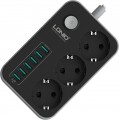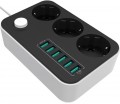Cable length
The length of the cable used to connect the surge protector to the network.
The longer the cable, the farther from the outlet you can install the device. On the other hand, a long cable can be inconvenient over short distances. Models on a coil are deprived of this drawback (see "Type"), this moment is compensated by the actual presence of the coil, but they differ in large dimensions and heavy weight. So when choosing, it is far from always worth chasing the maximum length of the wire.
Max. charging current
The current output by a USB connector when a charging gadget is connected to it.
The higher the current, the faster the battery can charge. However, when choosing, note that in order to use a high current strength, the connected device must also support it. Basically there are
USB with a current strength of 2.1 A,
2.4 A and
3 A.
It is also worth noting that when using several USB ports at the same time, the current strength is significantly reduced.
Power (with 1 device)
The maximum power that a USB port can produce when connecting only one gadget.
Higher power output speeds up the charging process. At the same time, there are a number of nuances associated with this parameter. Firstly, the appropriate power must be supported not only by the port, but also by the gadget being charged - otherwise the speed of the process will be limited by the characteristics of the gadget. Secondly, to take full advantage of the capabilities, you may need to support not only the appropriate charging power, but also a specific fast charging technology. Thirdly, in filters with several charging connectors, the maximum power per device can only be achieved if the other ports are not used.
Protection
—
Short circuit protection. Short circuit (short circuit) protection system — situations when the impedance in the circuit drops sharply, for example, due to a metal object falling between the socket contacts. It reacts to a sharp increase in current and opens the circuit, allowing you to avoid damage and fire equipment.
—
Voltage drops protection. Protection against power surges in the network. A filter with this function is able to completely cut off power that exceeds the allowable rate set by the manufacturer, protecting the load from damage. Note that the surge protector is not able to replace a full-fledged stabilizer or voltage relay; however, in more or less high-quality networks that are not subject to strong fluctuations, a filter is quite enough.
—
Overload protection. In this case, overload means a situation when the load power exceeds the values \u200b\u200ballowed for a given network filter. This situation is similar to the short circuit described above — high currents go through the filter; however, overload has its own specifics, so protection against it can be provided as a separate system. However, the principle of operation of such systems is classic: when the permissible power is exceeded, it turns off the power, preventing breakdowns and fires.
—
Varistor protection. A kind of protectio
...n against short-term power surges in the network, built on varistors — variable impedance resistors. The impedance of such a resistor under normal conditions is in the millions of ohms, but it drops sharply if the input voltage increases above a certain value. Due to this, in normal mode, the protection practically does not affect the circuit, and with a high-voltage pulse, excess energy “merges” through the varistor and dissipates in the form of heat. The ability of varistors to absorb energy is not infinite, therefore, to protect against overheating, the design usually provides for a temperature sensor with an automatic switch.
